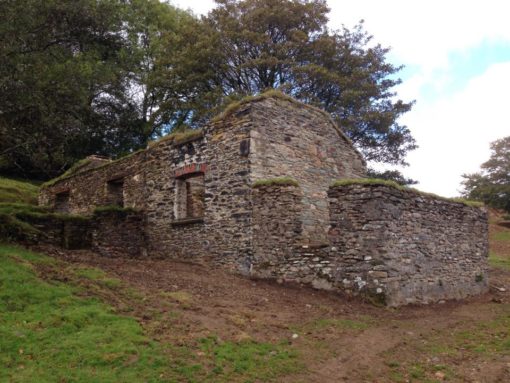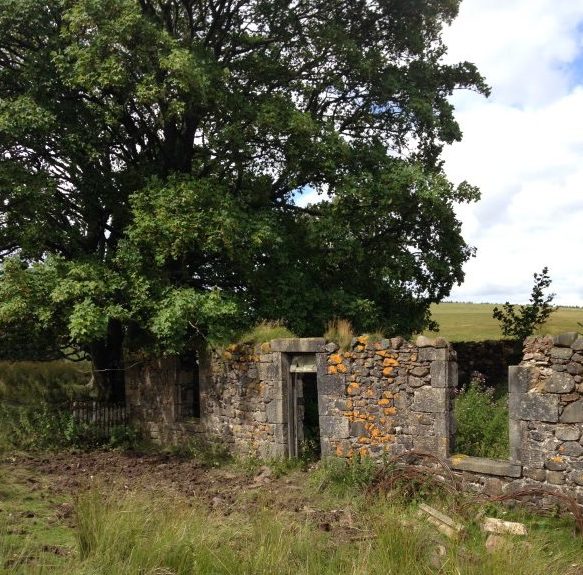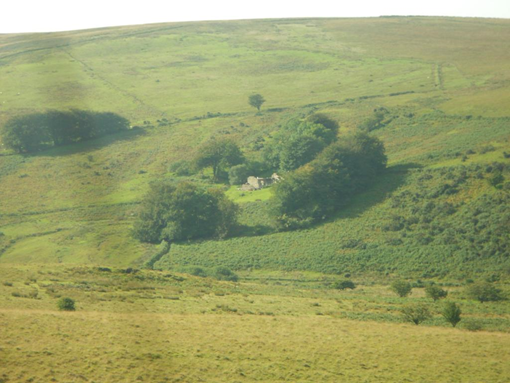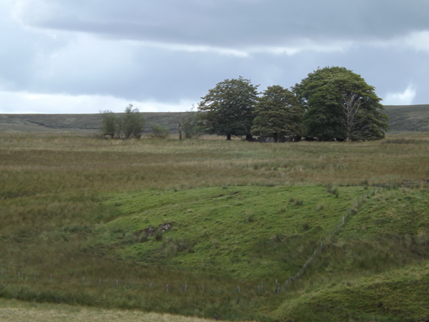In the 1860s and 1870s, Frederic Knight – who owned 16,000 acres of Exmoor – decided to experiment with introducing a type of year-round ‘sheep ranching’ on his Exmoor farms including on the herdings high up on the moorland hills. For hundreds of years before this time, sheep had been taken up to the hills for a few months in the summer to fatten up on the rich pasturing. The rest of the year the weather and conditions were too harsh up on the moor and the sheep were brought back down to the farms scattered around the lower hills and valleys of Exmoor. These included the new farms that John Knight, Frederic’s father, had built in and around Simonsbath. Knight is recorded as having little faith in either the local Exmoor Horn breed of sheep for his experiment nor the local Devonshire shepherds to achieve his plans. In the 1860s and 1870s, Knight began to purchase and import herds of Black Faced Sheep and Cheviots from breeders in and around the Scottish borders. It appears that Scottish shepherds – in some cases their wives and families – were ‘part of the sale.’ Their job including transporting the sheep down to Devon – by train, by boat and sometimes by foot using the old drover trails – and to get them settled in on Exmoor.
Scottish sheep breeder, Gerard Spooner, had already done this in 1852 when he transported several hundred sheep and 5 shepherds to Devon. Spooner moved man and beast by steamboat. It was a long journey for man and beast down the west coast of England from Scotland – the steamboats landed at Ilfracombe or Barnstaple. Spooner had some success down on Exmoor and convinced local Devon sheepfarmers, including Frederic Knight, that Scottish sheep and shepherds were ideal for expanding into the lucrative meat and wool markets in the ever expanding, industrial cities throughout England and Scotland.
Twenty years later, when Knight began his sheep farming experiment he was able to take advantage of the expanding network of steam trains being built through out Great Britain. It made the Scottish sheep and shepherd migration to Exmoor easier, cheaper and quicker. Many came from the Borders, particularly around Dumfries, Muirkirk and Lanark. The railway system had already established branches from Glasgow into the area – particularly to service the iron industries in the area. As was the case elsewhere, these branch lines also served local agriculture by enabling farmers to send their produce and stock to the growing urban markets hungry for milk, meat, vegetables, fruit, eggs etc. The infrastructure was in place for Knight to transport his sheep and shepherds south.
The map on the left shows the extensive rail network in place by the end of the 1850s and by the time of the Scottish shepherd migration to Exmoor the links in and around the Scottish Borders as well as from Exeter into Devon and Somerset were well established.
Taunton, Minehead and South Molton stations seem the most likely points of arrival for the Scottish migrants although Barnstaple and Williton may also have played their parts. Wherever the men, women, children and sheep arrived, they were offloaded, and the journey began up onto Exmoor and to the various sheepherdings that were their ultimate destinations. These included Badgeworthy, Larkbarrow, Duredon, Emmetts, Toms Hill, Warren, Winstitchen, The Mines and Hoar Oak to list a few. The final part of the journey would almost certainly have been by foot but hopefully the shepherds’ wives and children might have hitched a lift on the horse and cart which would carry their furniture and belongings along the bumpy, difficult trackways out to their new homes high in the Exmoor hills.
Shepherd, sheep and sheepdogs would have been a regular sight at the time moving across the moor. .
During the 1870s, 80s and 90s, over 5000 sheep and over 20 Scottish shepherd families migrated to Exmoor. They created a unique Scottish community of hill farmers based around the village of Simonsbath and under the leadership of Robert Tait Little who had come from Dumfries to be Head Shepherd on Exmoor from 1871 to 1907. Knight built several new farmhouses up in the hills as permanent homes for his Scottish shepherd families and he leased Hoar Oak Cottage which was already established as a shepherd’s hut in the north west corner of Exmoor. Between 1870 and 1910, four Scottish shepherds came to live and work at Hoar Oak Cottage.
Elsewhere you can find the stories about all four Scottish shepherds at Hoar Oak Cottage including William Davidson, John Renwick, James Maxwell Johnstone and Archie Jackson, but it is of particular interest to have found from that research that William Davidson, John Renwick and James Maxwell Johnstone were cousins, and all descended from John and Janet Johnstone of Greenburn Cottage, a sheepfarm tucked into a hill beside the Duneaton Water in the remote hills of Nithsdale and about five miles from Crawfordjohn in Lanarkshire.
A Similar Landscape: A Similar Way of Life
Greenburn Cottage, on the Duneaton Water in Lanarkshire, shares striking similarities with the landscape around Hoar Oak Cottage, on the Hoar Oak Water in North Devon. The photographs below illustrate. Clearly the Scottish shepherds who made their way down to Exmoor were going to a landscape and a working environment they would recognise – open trackless moorland, boggy, peaty ground with changeable and challenging weather. These men and their wives and families would be well acquainted with this type of landscape and the lifestyle of the hill shepherd.
The Other Scottish Shepherds on Exmoor
As The Friends of Hoar Oak Cottage continued their research more Scottish shepherds on Exmoor were discovered – some were related others not.
Another grandson of the Greenburn Johnstones mentioned above – William Johnstone – was found living and working at Badgeworthy Farm – about five miles across the moor from Hoar Oak – between 1872 to 1875. William came south with his wife Jane Saddler who was also born and raised in Crawfordjohn and the couple had a daughter on Exmoor before returning home to Scotland.
Another Renwick family, William and his wife Mary Henderson who was, once again also born in Crawfordjohn, were found to be living and working as shepherds a few miles away in Lydford, Devon in the 1870s.
The list below gives all of the names of Scottish migrant shepherds, discovered to date, who lived and worked on Exmoor between 1860 to 1900. Some descendants of these families have been in touch and given full information and details about their family. Others are still just ‘names’ and it would be intriguing to find out more.
George Anderson: little is known but seems linked to the Thomas Graham family (see below).
Thomas Armstrong b1858 Kirkcudbrightshire. Arrived on Exmoor with wife Maggie in 1893/94. The 1901 census records their family at the Badgworthy herding with James (b1891Scotland), George (b1893 Scotland), Thomas (b1894), Robert (b1896); Maud (b1898); Dorothy (b1900); all born at Badgworthy on Exmoor.
William Bain: No information available.
David Bryden (b1841) and wife Margaret (b1845) were possibly from Kirkcudbrightshire and had one daughter Margaret (b1870) whose birth was registered at Barnstaple Registry Office. All three are found in the 1871 census living and working at Badgworthy Cottage.
William Blythe: No information available.
Hugh Buckingham: No information available.
William Dagg: No information available.
William Davidson: More information available. Please contact us.
Thomas Graham came from Biggar, Crawfordjohn to Exmoor 1875. Follow the link for full information.
John Gourdie (b1849 Glenfarg, Perthshire) arrived on Exmoor some time before 1881 and married Selina Tucker in 1882. Name may have been ‘Goldie’.
William Hepburn (b1864) was recorded as from Scotland in the 1881 census and was lodging with/working for the Howatson family (see below) at Badgeworthy herding.
John Hewitt (b1860) and his wife Janet (b1860) travelled to Exmoor from Dailly, near Girvan in Ayrshire, with two children, Alexander (b1886) and Jane (b1892). Another child, James, was born in 1895, possibly at Pinkery where they are recorded as living in the 1901 census. An older daughter, Mary (b1884 in Scotland) does not appear with them on censuses in England and may have stayed behind in Scotland.
William Howatson came from New Cumnock, Lanarkshire and went with his wife to Exmoor in the late 1870s. Their descendants, who live in New Zealand, have shared photos and the family history. To come on the website or please contact us. Note: the family in NZ know themselves as Hewitson although the records show the name as Howatson.
Archie Jackson More on this link.
James Maxwell Johnstone: More on this link.
William Johnstone (b1844 Muirkirk) and wife Jane (b1844 Crawfordjohn) made the trip to Exmoor in 1871 to take up the Badgworthy herding and had one child – Helen (b1872) – before returning to Scotland.
Robert Tait Little (b 1842) from Dumfrieshire was Head Shepherd on Exmoor from 1886 until 1907 and left a wealth of information in his diaries. More on this link.
William Little (b1851 Deepsdyke Cottage, West Linton, Peebleshire) m Margaret Trench, had 4 children in Scotland, James, Anne, Christina and John (b1874). Six weeks after John’s birth William, Margaret and the children were on Exmoor putting their date of arrival around the end of May, 1874. More on this link.
Dougal MacDougal (b 1857 Drymen, Stirlingshire) arrived on Exmoor in 1894. In the 1901 census is living at West Gate Cottages, Simonsbath with wife Ellen nee Tait Little (b1873) and in 1911 moved to the Wheal Eliza Mine herding near Simonsbath. For more information go to this link.
Peter Murray (b1848) wife Christina (b1856) daughter Margaret (b1877) were all been born in Moffat, Dumfriesshire. Six more children, Peter (b1879 Lydford) then David (b1881), Christina (b1884), James (b1886), Mary (b1888) William (b1891) were born and all registered in South Molton, Devon. The 1891 census records the family on Exmoor at the Larkbarrow herding.
Adam Reid: No information available although he may be buried in South Molton.
John Renwick More on this link.
William Renwick (b1856) and wife Mary worked in Lydford, Devon in the 1880s and 1890s and had a boarder, shepherd William Geddes (b1868 in Peebleshire).
William Scott (b1809 Roxboroughshire) accompanied Gerard Spooner (see below) to Exmoor around 1852 and the Scott family includes: wife Margaret (b1808) Selkirkshire, Agnes (b1837), Thomas (b1839), William (b1841), Rachel (b1843), Margaret (b1845), Helen (b1847). The 1871 census records the family at Winstitchen Farm except for the three eldest daughters and eldest son William who appear to have been boarding with a family in Dulverton.
Gerard Spooner came to Exmoor around 1852 and is recorded in the North Devon Journal as arriving on a ship from the Isle of Skye to Ilfracombe. The article states that along with its normal cargo, the ship, the Glendower, was transporting sheep and 5 shepherds and their families to live and work on Exmoor. William Scott accompanied Gerard Spooner in 1852. More on this link.
If you would like to know more or have information to share please contact us.





